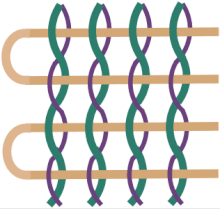Leno weave

Leno weave (also called Gauze weave or Cross weave[1]) is a weave in which two warp yarns are twisted around the weft yarns to provide a strong yet sheer fabric. The standard warp yarn is paired with a skeleton or 'doup' yarn; these twisted warp yarns grip tightly to the weft which causes the durability of the fabric. Leno weave produces an open fabric with almost no yarn slippage or misplacement of threads.
Uses

Leno weave fabric allows light and air to pass through freely so are used in any area where a sheer, open weave fabric is required that will not bruise (where the threads shift away from their woven uniformity disturbing the beauty of the weave). If a simple in-and-out flat weave were woven very loosely to achieve the same effect the threads would have a tendency to this bruising. Leno weaves are often used for window treatments and for sheer layers for fine clothing. When made with glass fibre or other strong yarns or when permeated with a strengthening compound it can be used as an engineering material in construction,[2] though due to the openness of the fabric if a solid covering is required it is often used in conjunction with other weave styles.[3]
Here are some common items made from leno woven fabric:[4]
- Produce bags - onions, potatoes, cabbage etc
- Shellfish bags - oysters, mussels and clams
- Firewood bags
- Curtains and drapery
- Mosquito netting
- Clothes
Production
To produce a leno weave, the loom is threaded with the warp yarn and a doup yarn together. The doup yarn can be of similar or lesser weight and strength. The weft is woven in and for each weft shuttle the warp yarns are twisted interchangeably to produce a figure of eight pattern.
Karamiori
Karamiori or Japanese Leno Weave includes all loom techniques that make use of intertwining threads to create the structure of the weave.[5] Karamiori is an old and highly respected textile production method. The Japanese divide karaori into three basic styles based on structure: sha (紗), ro (絽), and ra (羅). Sha is the basic leno weave, Ro adds additional areas of flat or twill weaves and Ra maintains the concept of twisted threads but allows both warp and weft to be freed and recombined to form highly intricate weaves.
References
- ^ I.C.S. Staff. (1905) Leno Weaves (PDF) On-Line Digital Archive of Documents on Weaving and Related Topics: Leno Weaves, International Textbook Company. Arizona Computer Science. Retrieved August 4, 2012.
- ^ HexForce Technical Fabrics Handbook. Seguin, Texas: Hexcel, Inc. Retrieved August 4, 2012.
- ^ Woven Fabrics. NetComposites. Retrieved 1st October 2018.
- ^ Moellman, Mark (May 2017). "Woven Leno Bags - for Shellfish and Produce". www.interbulkexpress.com.
{{cite web}}: Cite has empty unknown parameter:|dead-url=(help) - ^ Marshall, John. (June 27, 2011). Traditional Techniques: 絡み織り Karamiori. Retrieved August 4, 2012.
